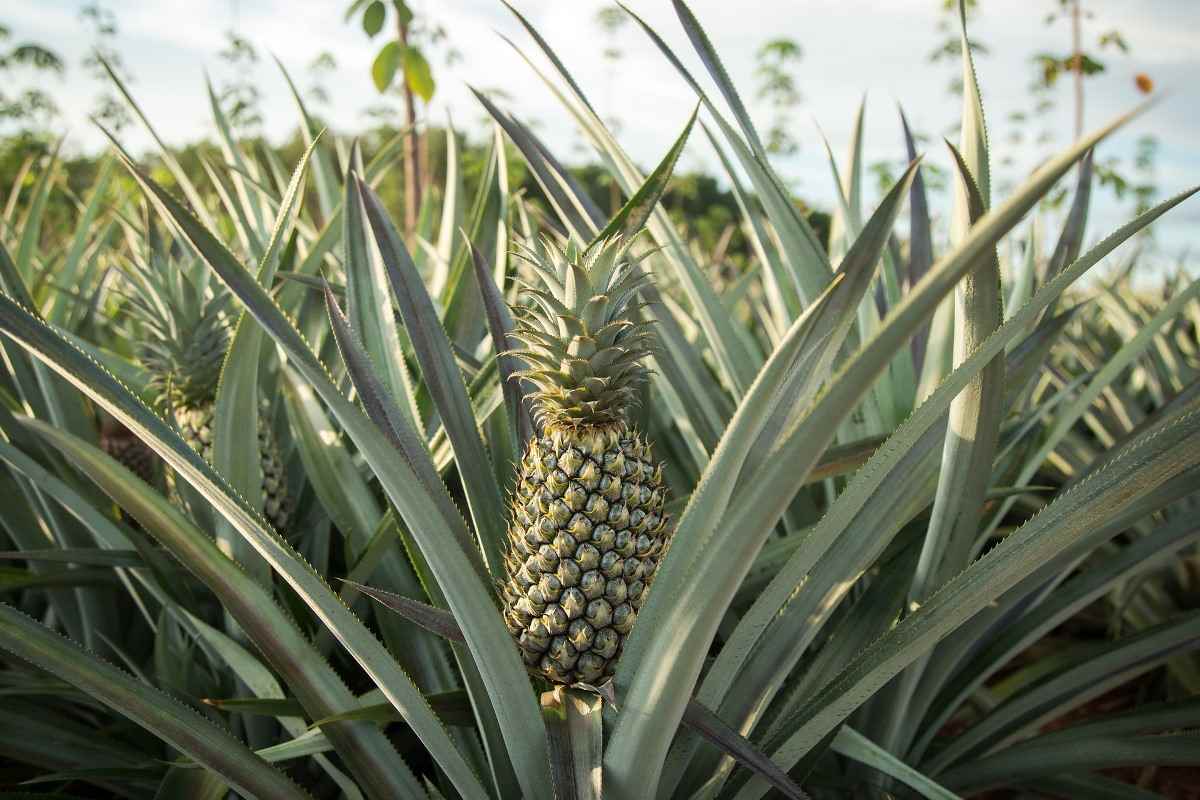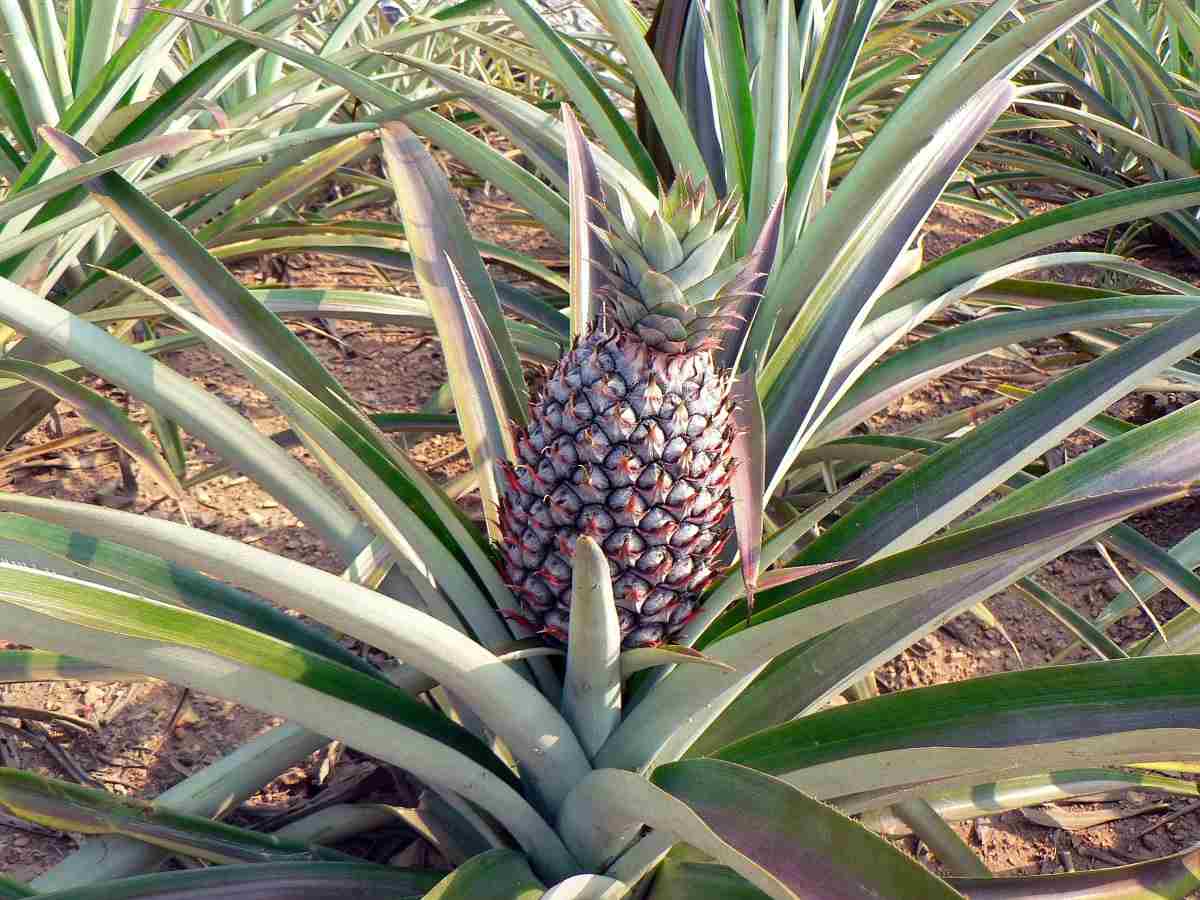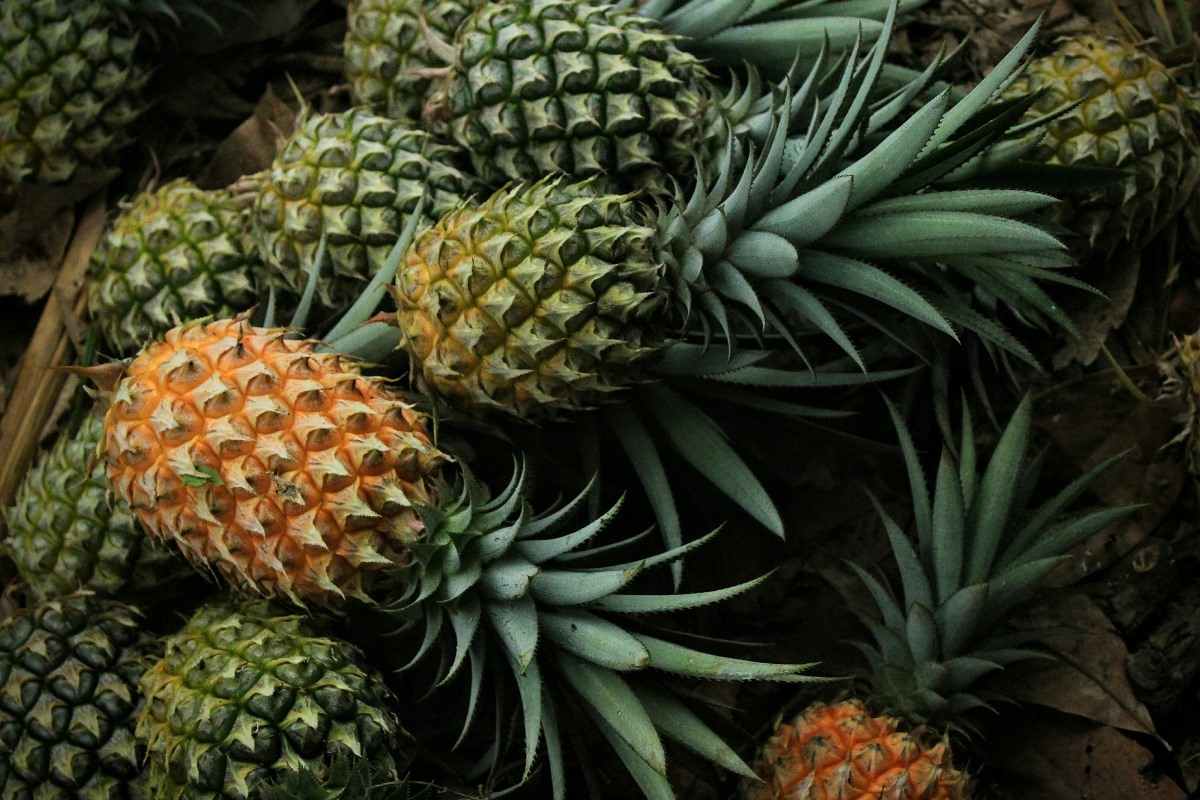High Density Pineapple Planting
India is the largest producer of several fruits in the world. The average productivity of fruits in India is low as compared to many developed countries. Pineapple is one of the most important commercial fruit crops of the Bromeliaceae family in the world. It is one of the most important tropical and sub-tropical fruit in India.
Pineapple is one of the commercially important fruit crops of India and it is the most economically significant plant in the family Bromeliaceae. India is the 5th largest producer of Pineapple with an annual output of about 1.2 million tonnes of fruits. Other leading producers in Pineapple are Thailand, the Philippines, Brazil, China, Nigeria, Mexico, Indonesia, Colombia, and the USA. High density means increasing the plant population per unit area for increasing the production of crops.
A Step-by-Step Guide to High Density Pineapple Planting in India
- Types of Pesticides Used in Agriculture: A Beginner’s Guide
- Economical Aquaculture: A Guide to Low-Budget Fish Farming
- 15 Common Planting Errors That Can Doom Your Fruit Trees
- How to Make Houseplants Bushy: Effective Tips and Ideas
- Innovative Strategies for Boosting Coconut Pollination and Yield
- Pollination Strategies for Maximum Pumpkin Yield
- The Complete Guide to Chicken Fattening: Strategies for Maximum Growth
- Natural Solutions for Tulip Problems: 100% Effective Remedies for Leaf and Bulb-Related Issues
- Revolutionizing Citrus Preservation: Towards a Healthier, Greener Future

Advantages of High Density Pineapple Planting
- High density is the latest advanced planting technology applied in Pineapple cultivation. In the tropical region under low density planting 20 to 25% of fruits become unmarketable due to sunburn.
- High-density plant spacing has the advantages of increasing crop yield, reducing weeds, increasing suckers and slip per unit area, and reducing the incidence of sunburn due to shading. Though, it is found that a 10% decrease in yield occurs with every 20% decrease in solar radiation.
- Best utilized of land and resources.
- Increase in yield per unit area.
- Quality production of fruit crops.
- High density is easy for interculturings operation, plant protection, and harvesting.
- To obtain an export quality of the harvest.
- To overcome low productivity.
- To reduce the gestation period for early returns.
Major Pineapple Producing States or Areas in India
Pineapple is an important fruit of India and it is cultivated in an area of 89 thousand hectares and total production is approximately 1,415.00 thousand tons. It is mostly cultivated in the North East region, West Bengal, Bihar, Goa, Kerala, Karnataka, and Maharashtra states.
The area under Pineapple cultivation in India increased by 35% from 57 thousand hectares. The Pineapple growing states are Assam, Meghalaya, Tripura, Manipur, West Bengal, Kerala, Karnataka, and Goa. The other states where Pineapple is grown on a small scale are Gujarat, Maharashtra, Tamil Nadu, Andhra Pradesh, Orissa, Bihar, and Uttar Pradesh.
As the population of India is high so maximum produced Pineapples are consumed by Indian people themselves and the rest of the very least are exported to middle-east and western countries. After extraction of juice, the flesh of Pineapple is used as animal feed and cuisine. Besides these, Jam, Jelly, Squash, Vinegar, etc are made from Pineapple. Among all the fruits, ripen Pineapple is highly perishable; and it cannot be kept more than 3 to 4 days after harvesting.
Pineapple Varieties for High Density Pineapple Planting in India
There are different varieties of Pineapple are grown in India. About 80 to 90 varieties of Pineapple are grown in different countries of the world. The popular commercial Pineapple variety in India is Giant Kew. The other main varieties of Pineapple which are grown in India are Kew, Queen, Mauritius, Lakhat, Jaldhup, Charlotte, Rothchild, Desi, Amrutha, and MD-2. Having different varieties they are grown in different seasons in different states of India but the main growing season of whole India is July-September.
The ‘Kew’ variety belonging to the Cayenne group is the leading commercial variety and its properties are considered suitable for canning purposes. ‘Charlotte Rothchild’ Pineapple variety is partly under cultivation in Kerala and Goa. Fruit characteristics and taste are similar to Kew and Queen Varieties.
Soil and Climate Requirement for High Density Pineapple Planting
The Pineapple crop is suitable for cultivation in humid tropics. The Pineapple fruit grows well near the sea coast as well as in the interior; so long the temperatures are not extreme. The high-temperature level at night is deleterious for the growth of the plant and a difference of at least 40⁰C between day and night temperatures is desirable. It can be grown up to 1,000 meters above sea level if the area is frost-free. The rainfall requirement ranges from 100 to 150 cm. Sandy loam soils with a pH level between 5.0-6.0 are ideal for the growth of the plants. The area with fertile soil having good drainage is to be selected for Pineapple cultivation. Field preparation is to be carried out by clearing previous vegetation and loosen the soil for the early establishment of the Pineapple plant.
A humid climate with ample rainfall is ideal for Pineapple cultivation. The optimal temperature for Pineapple must be between 22 and 32⁰C. While the plant leaves grow best at 32⁰C, roots grow best at 29⁰C. The Pineapple plant does not grow at temperatures below 20⁰C and above 36⁰C. There should be a difference in 4⁰C between day and night temperatures. Though, a high temperature at night is not desirable for Pineapples. Ample rainfall is well-suited for Pineapple plants and it grows best at 100-150 cm rainfall.
Best Season for High Density Pineapple Planting
The main season of planting is April-May and August-September, but Pineapple can be planted in all months except during heavy rains of June-July. The best time for planting in August. For getting the maximum price and keeping better quality, the best planting time for Pineapple is April-May. During the summer season, if there are no summer showers after planting, irrigation should be given 3 weeks after planting for proper establishment.
Planting Material for High Density Pineapple Planting
- Usually, Pineapple is propagated by sucker, slip, and crown. These planting materials of 5 to 6 months age bear flowers after 12 months of planting except crowns which bear flowers after 19-20 months.
- Pineapple plants produced through tissue culture are also available for plant cultivation.
- Various planting systems adopted in fruit crops are square, triangular, quincunx, rectangular, hexagonal, hedgerow (single & double), paired planting, and cluster planting.
- Hedge row system in Pineapple crops in India.
Propagation Methods for High Density Pineapple Planting
Generally, Pineapple is very easy to propagate vegetative and suckers arising in the axil of the leaves. Another process of propagation is by slips, which are the suckers, arising immediately below the fruit. Though, Suckers and slips must be preferred for planting as they come to bearing earlier than the crown and also produce larger fruits. Pineapple plants from crown bear flowers after 3 to 20 months later than suckers and slips depending on the climatic conditions. So, crowns are not normally used. Generally, suckers must be planted within 2 weeks after removing from the mother plant. The planting material for Pineapple propagation must be selected from a healthy disease-free plant.
The performance of the plant depends on vigor, growth rate, and time is taken for bearing fruit size, and quality of planting material. Besides type and size of plant material also results in variation in the performance of Pineapple plants. If planting material of different types and sizes is used, it results in a poor rate of plant establishment, uneven growth of the Pineapple plants, uneven flowering and harvesting stretched over a long time. Uniform cultural operations cannot be taken up.
Ultimately plant-wise operations are to be followed resulting in increased cost of production in Pineapple. In a mixed planting, a few Pineapple plants flower while others become ready for harvesting, posing problems for getting good uniform ratoon crops also. So, it is always advisable to use uniform-sized material of monotype. Therefore, the selection of the right type and size of planting material is essential for commercial plantings.
In suckers and slips, larger planting material results in more vigorous Pineapple plants. Of the types and sizes of propagules tried, slips and suckers weighing about 350 and 450 grams respectively are ideal for higher crop yield with better productivity. In case of non-availability of slips, suckers weighing about 500 grams are ideal for planting. In case of non-availability of suckers, slips weighing about 350 grams are best.
Spacing or Plant Distance in High Density Pineapple Planting
In case if you miss this: Organic Hop Shoots Cultivation.

For commercial viability, high density cultivation is recommended for crops. Planting density of 63,400 plants/hectare (22.5 x 60 x 75 cm.) is ideal for sub-tropical and mildly humid conditions, whereas for hot and humid conditions a plant density of 53,300 plants/ hectare spaced at 25 cm. Though, a decrease in fruit weight was quite evident when plant-to-plant spacing was reduced to 20 cm and row-to-row to 40 cm irrespective of the spacing between beds. In rain-fed, high fertile, and hilly areas in northeastern states, a somewhat lower density of 31,000 plants/hectare is recommended.
Two-Row Trench System in High Density Pineapple Planting
Two-row trench system of planting is the best for high density Pineapple planting in the plains, whether the crop is grown with or without irrigation. The field is laid out into about 22.5 to 30.0 cm deep trenches alternating with mounds. In each trench, 2 shallow furrows about 10 to 15 cm deep and 15 cm inside from the edge of the trench are opened and suckers are planted in these furrows, so arranged that 2 plants will not be exactly opposite to each other. The spacing of Pineapple plants mainly depends on the growth of the plant. Soil moisture and fertility influence growth and indirectly determine to space required per plant and eventually planting density. In the overall analysis, the plant-to-plant spacing of about 22.5 to 25.0 cm and row-to-row spacing of 45 to 60 cm are ideal. Where Pineapple plants produce luxuriantly with long leaves, a wider spacing of 90 cm between the trenches is required. But in places where the growth of the leaf is moderate in Pineapple plants, a trench-to-trench spacing of 75 cm is adequate.
The initial establishment of planting material in the field is important to avoid gaps and the subsequent poor growth of replants under the competitive situation of high density planting. Suckers weighing 500-600g and slips weighing 350-400g are the best for initial field establishment under high density Pineapple planting. July-August is found to be the best season of planting for establishment and plant growth. To avoid any reduction in fruit size to unmarketable levels due to interplant competition for plant nutrients need to be done more scientifically than under low-density planting. To obtain a good crop yield from high density planting, application of fertilizers and plant spacing with flower-inducing chemicals are considered very important.
Planting Process in High Density Pineapple Planting
- Planting is generally done under a traditional system or high density planting (HDP) depending on the choice of farmer and availability of planting materials.
- Pineapple is planted from September to October. However, if an irrigation source is available planting can be done at any time.
- Under the traditional system plant spacing of 50 to 100 cm is adopted whereas in HDP spacing of about 30 cm X60 cm X90 cm is planted in double rows.
- Apply 500 g of Farmyard manure (FYM) per plant at the time of planting.
Irrigation Requirement for High Density Pineapple Planting
Pineapples are cultivated in coastal areas and places where rainfall is abundant. Therefore, irrigation is not needed. Though, if cultivated on a commercial scale supplementary irrigation helps in producing good-sized fruits. Also, irrigation helps in off-season planting. It also ensures all year round Pineapple production. This practice is followed for producing export quality Pineapple fruits. If grown in areas of scanty rainfall with hot weather, then irrigation must be done once in 2 weeks.
Although the Pineapple crop is mainly a rain-fed crop, it is widely irrigated. Drip irrigation is successfully used where the water supply is restricted, the cost of labor is high and cultivation methods are advanced.
Fertilizers and Mulching Requirements for High Density Pineapple Planting
Dry leaves or straw is used as mulching material in Pineapple. Also, mulching with black polythene and sawdust is effective. The maturing fruits can be covered with rice straw or Pineapple leaves to reduce both sunburn and damage caused by the birds.
Regular fertilization can do wonders for a Pineapple. Nitrogen is a vital building block for young Pineapple plants. And, a dry fertilizer that has 6 to 10% nitrogen, 6 to 10% potash, 6 to 10% phosphoric acid, and 4 to 6% magnesium works well. Young plants must be fertilized every 2 months or so during the growing season.
Pineapple plants require heavy manuring. Application of about 20 to 30tonnes/hectare of cow dung / FYM / compost at the time of planting is essential for a good crop yield. It can absorb nitrogen in the form of ammonia. Ammonium Sulphate is the best fertilizer for it. It is recommended to give fertilizers at the rate of about 8:4:8 g N: P2O5:K2O per plant per year. Nitrogen and potash must be applied in 6 split doses at bimonthly intervals, except during heavy rains. The first dose of fertilizer is given 2 months after planting and the entire phosphorus can be given at the time of planting. The application of fertilizer in rain-fed areas has to be done when moisture is available. Sometimes zinc deficiency appears in Pineapple which leads to a condition called Crookneck and spraying of 0.5% zinc sulphate can prevent it.
Pruning Requirement in High Density Pineapple Planting
In Pineapple, pruning is generally practiced which refers to removal or trimming of excessive basal shoots, upper crown portion, and suckers. This is done to encourage aeration between the plants, and to encourage light interception, to avoid pest and disease build-up, and for ease of cultural operations, ultimately to get a good yield and quality fruits. It is found from research that earlier slip pruning has more positive effects on average fruit quality than later pruning. It was shown in Pineapple that the least developed plants at flower induction produce lighter fruit than well-developed Pineapple plants. So by early pruning of the slips of the least developed plants, it is assumed that a higher uniformity in fruit weight and length might be achieved. And, a practical criterion for farmers to identify the least developed plants after flower induction would be the length of the developing inflorescence.
Weed Control in High Density Pineapple Planting
For effective and economic weed control in crops, use weedicides. Pre-emergent spray with bromacil 2.5 kg in 600 liters of water per hectare controls all types of weeds in Pineapple plantation. If there is subsequent growth of weeds, herbicide application can be repeated at half the above dose. Spraying must be done when there is adequate moisture in the soil and avoid periods of heavy rainfall for spraying.
Plant Protection Measures in High Density Pineapple Planting
No serious pests or diseases are noticed in the Pineapple crop except for the light incidence of leaf spot disease and mealy bugs. For control of leaf spot, spray any one of the below fungicides when symptoms of the disease are;
- Bordeaux mixture 1%, 225 liters/ha
- Zineb 1 kg in 225-liter water/ha
- Mancozeb 1 kg in 225-liter water/ha
Insect Pests – Usually, Pineapple is free from pests except for infestation of mealybugs and scale insects in sporadic cases.
Diseases – Diseases are not common except stem rot in the case of Pineapple plants. Some control measures include good drainage and dipping the suckers in Boradeaux mixture before planting.
For control of mealy bugs, apply quinalphos at 0.05%. Then, destroy grasses and other monocot weeds, which serve as alternate hosts for the pest.
When and How to Harvest Pineapple Fruits
Ratooning in high-density planting reveals that the average fruit weight in the first and second ratoon is about 88% and 79% respectively of the plant crop. Also, the plant stand is reduced resulting in the reduction of fruit yield by 49.3 and 46.2% in first and second ratoon crops respectively. Prolonged ratooning results in the reduction of flowering plants, consumer appeal of the fruit, fruit size, and several fruits suitable for canning, but in the increase of fascinated fruits. Also, it is not possible to prevent the reduction of fruit yield in ratoon crops by increasing the irrigation or by higher doses of nitrogenous fertilizers.
- Pineapple fruits can be harvested from 18 to 24 months after planting.
- A slight color change at the base of the fruit indicates maturity.
- Harvesting is to be done with a sharp knife retaining a 5 to 7 cm stalk.
- Care should be taken and avoid mechanical injury of fruit.
- Immediately after harvesting fruit, cool to fruit at shade before packing.
The yield of High Density Pineapple

- The average yield of Pineapple is 50 – 60 tonnes per hectare
- Under HDP Pineapple yield may 80 – 100 tonnes per hectare
Pineapple Farming Profit per Acre in India
The pineapple farming profit per acre in India depends on many factors such as cultivation practices, market demand, variety of fruit, pineapple growing season in India, and crop management. If you have a proper pineapple farming business plan, you can make good profits in pineapple farming.
Disadvantages of High Density Planting
- Less life span of the fruit.
- Difficult to manage the tree canopy.
- It requires high techniques for the maintenance of fruit trees.
Nice Information.